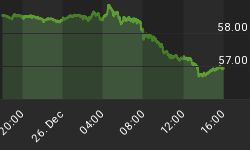Add Iraq To List Of Concerns

U.S. investors have been unsettled by Russian troops, economic concerns in Europe, and a possible shift in the Fed's interest rate time table. If that was not enough, the term airstrikes is being used to describe possible scenarios in Iraq. From The Wall Street Journal:
The Obama administration is considering airstrikes against Islamic militants in northern Iraq in a move to protect American personnel in the city of Erbil as Islamic militants pose a growing threat to the country's Kurdish heartland, U.S. officials said. U.S. officials described the likelihood President Barack Obama will authorize airstrikes as increasing. Airstrikes could come even before those humanitarian airdrops, or shortly afterward, officials said, emphasizing that as of Thursday afternoon, the White House had not made any decisions to strike.
Support Can Help With Countless Inputs
Given the potentially bullish implications of a strengthening U.S. economy and the long list of counterbalancing concerns, it can be difficult to make investment allocation decisions. Sometimes the simple concepts of support and resistance can help. The chart of the S&P 500 below shows the market is nearing a trendline that has provided support in the past (see green arrows). The red arrows highlight previous areas of resistance, between 1897 and 1902, that may now attract buyers near the blue arrow.

How can the chart above help us? If support holds, it will increase the odds of a potential bounce-back rally in U.S. stocks, meaning we can exercise some patience with our equity ETFs (VTI). If support does not hold, the odds of further weakness will have increased, and it becomes easier to consider additional defensive chess moves. We learn something either way.
ECB Leaves QE Door Open
The stock market loves quantitative easing (QE) since it injects money into the financial system. Europe is sending somewhat conflicting signals to U.S. investors. The bad news is the European economy is showing some signs of ongoing strain. For example, Italy released negative GDP figures this week. The good news is the European Central Bank (ECB) could launch a QE program in an attempt to spur economic activity and combat persistently low inflation. From Bloomberg:
European Central Bank President Mario Draghi said the risks to the recovery from conflicts including that in Ukraine are increasing. Headwinds facing the 18-nation euro area's recovery are intensifying after Italy slipped back into recession and the standoff between Russia and the U.S. and its allies escalated into the worst such conflict since the Cold War. Draghi has said large-scale asset purchases are an option for dealing with a severe economic shock, leaving investors seeking clarification on what the trigger could be.
Bulls Typically Stagger Before They Fall
There is another reason to monitor key support on the S&P 500 - a snap back rally remains possible. Prior to the recent bout of weakness in U.S. stocks, the technical picture has been favorable. If we also consider relatively strong economic data, it tells us to keep an open mind about the next move in equities. Even if the bears get their hoped-for significant correction or bear market, tops can form over time. For example, it took the Dow nearly three months to peak in 2011 (see chart below). A sign of weakness emerged when the slope of the 50-day rolled over in early June 2011 (see orange arrow on left). After a scare, the Dow staged a significant bounce-back rally all the way to point A; a similar rally remains a possibility in 2014.

Odds Of A Recession?
How does the bigger picture look today? It is a mixed bag. From a negative perspective, the 50-day is starting to roll over (see orange arrow below). From a positive perspective, the Dow is still holding above its 200-day moving average, telling us many blue-chips remain relatively healthy from a longer-term perspective. Another positive is the health of the U.S. economy. Bear markets are typically associated with recessions. The U.S. economy does not appear to be at high risk of an imminent recession (based on the data we have in hand).

Investment Implications - The Weight Of The Evidence
On August 6, we listed 1911 on the S&P 500 as a bull/bear guidepost. On August 7, the S&P 500 closed at 1910 and change. How does that help us? We used it as a reference point and trigger to see if our current allocation was in line with the market's current profile. In our case, the answer was "our cash and bond positions remain sufficient to offset the risk of further downside in our equity holdings (SPY)". Therefore, by rule, we made no changes Thursday. However, market weakness on August 7 did nothing in terms of making the market "prove it to us". If stocks cannot post gains Friday, the odds are good we will reduce equity exposure for the fifth time since July 24. If stocks can rally Friday and hold key support shown above, we will be more apt to maintain our current exposure to stocks. It should be noted that making no moves on August 7 does not mean everything is rosy for stocks. To the contrary, the market's profile is currently so concerning that we have already cut risk significantly, with the first defensive step coming back on July 25. We will enter Friday's session respecting both the "highly vulnerable to even a plunge scenario" and "potential support is in the neighborhood" scenario.
















